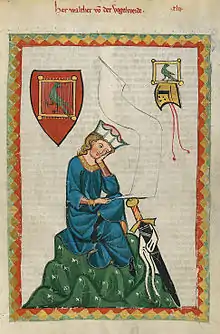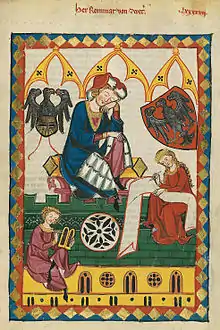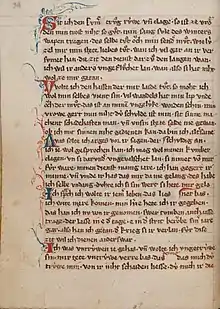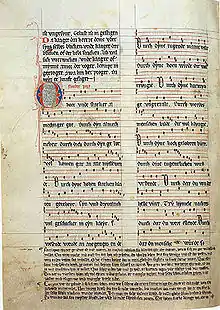Middle High German literature
Middle High German literature refers to literature written in German between the middle of the 11th century and the middle of the 14th. In the second half of the 12th century, there was a sudden intensification of activity, leading to a 60-year "golden age" of medieval German literature referred to as the mittelhochdeutsche Blütezeit (c. 1170 – c. 1230). This was the period of the blossoming of Minnesang, MHG lyric poetry, initially influenced by the French and Provençal tradition of courtly love song. The same sixty years saw the composition of the most important courtly romances. again drawing on French models such as Chrétien de Troyes, many of them relating Arthurian material. The third literary movement of these years was a new revamping of the heroic tradition, in which the ancient Germanic oral tradition can still be discerned, but tamed and Christianized and adapted for the court.
| History of literature by era |
|---|
| Bronze Age |
| Classical |
| Early Medieval |
| Medieval |
| Early Modern |
| Modern by century |
|
|
Historical overview
The vernacular literature of the Old High German period, written in abbeys and monasteries, had been encouraged by the Carolingian dynasty in order to support the work of the church in recently Christianized lands. This eventually lost its urgency under the subsequent Ottonian and Salian emperors, and official promotion of the written vernacular lapsed. The result was a period of around 150 years c. 900 – c. 1050 when there was almost no new writing in German.[1][2]
By the middle of the 11th century, there was an increasing preference for German over Latin in writing in the courts, and Henry the Lion was just the first of the princes, in 1144, to establish his own court chancery.[3][4] At the same time there was a growing audience among the nobility for literature in the vernacular (as was already happening in France and England).[5][6]

The earliest works of this period, such as the Ezzolied and Annolied, were still the product of clerical authors with a biblical subject, but now directed towards a lay audience at the noble courts, rather than the clerical audience of the Old High German compositions.[6]
By the middle of the 12th century, though, more secular works such as the Kaiserchronik ("The Imperial Chronicle") and the Alexanderlied introduced more worldly subject matter, though still within the religious world-view.[7] In the same period, the love lyrics of the Danubian poets mark the start of the Minnesang tradition.[8]
Under Frederick Barabarossa (ruled 1155–1190), political stability and increasing wealth encouraged the nobility to "assert its identity in activities that enhanced its visibility and prestige", among which were the patronage of vernacular literature, sponsoring new compositions, and the performance and copying of existing works.[4] This new, largely secular literature introduced "new ways of thinking, feeling, imagining", seen in the courtly concerns with romantic love, the challenges and obligations of knighthood, and a striving for personal honour.[9][10] Religious concerns were not lost, but the issue was now how to reconcile worldly and divine obligations.[11]
From around 1170 Old French romances and the songs of the Provençal troubadours and French trouvères inspired MHG adaptations, which even from the start showed great independence from their sources.[12] The following decades were a "golden age" (German Blütezeit), a sixty-year period which saw the creation of works recognized by both contemporaries and later generations as classics: the courtly romances of Hartmann von Aue, Gottfried von Strassburg and Wolfram von Eschenbach, and the songs of the Minnesänger, most notable among them Walther von der Vogelweide.[13][14]
Also among these classic is the heroic epic the Nibelungenlied, which drew for form and subject matter on Germanic oral tradition rather than Romance models.[15] Other types of narrative with connections to oral tradition in the broader MHG period are the earlier Spielmannsepen ("minstrel epics") and the later epics surrounding the legendary figure of Dietrich von Bern.[16]
In the later MHG period from about 1230 (sometimes termed "post-Classical"),[17] poets built on the achievements of the Blütezeit and expanded the scope of German literature in form and subject matter. New genres included a new style of short tale (German Märe).[18] Neidhart broadedned the scope of the love-lyric with peasant characters and a satirical tone,[19] while political uncertainty prompted a rise in didactic and political songs from the Spruchdichter in the footsteps of Walther.[20] With the writings of the mystics, which for the first time included a number of female writers, this period also saw the first developments in literary prose.[21]
By the mid 14th century, however, with courtly culture in decline, the genres which had dominated MHG literature ceased to attract writers, and a new literature, centred on the towns and their urban patriciate, started to develop.[22] Even in the following period, however, the old stories were copied and adapted for new audiences, with the result that many MHG works survive in 15th century and even later copies, while the Meistersinger continued to develop the work of the Sangspruchdichter and were still using melodies of Walther's for new songs.[23][24]
The Poets
There is little biographical evidence about the MHG poets.[25] The epic poets generally name themselves in their works, and the Minnesänger are identified in the manuscript collections, but works based on oral tradition are typically anonymous. [26]

For the higher status Minnesänger there is often documentary evidence, such as the account of the death of Friedrich von Hausen on the Third crusade, mourned by the whole army.[27] However, even a poet as famous as Walther von der Vogelweide is mentioned in only a single offical document,[28] and we know little about the narrative poets apart from what they say about themselves in their works and remarks by later writers.[29]
Given the time it would take to write such works, the epic poets would necessarily have been dependent on long-term patronage, and the many incomplete works may indicate a loss of patronage.[30] Most Minnesänger were of high noble rank (including the Holy Roman Emperor, Henry VI) requiring no patronage. For them song would have been an occasional pastime, to enhance their prestige, and their œuvre is correspondingly small.[31] The large number of songs and the increasing artistry from Minnesänger such as Reinmar, Walther and Neidhart, on the other hand, suggest professional court musicians from the ranks of the unfree nobles (ministeriales). Much lower on the social scale were the Spruchdichter with their didactic and political songs — wandering minstrels who had limited legal rights.[32][33]
Manuscripts and patrons

_fol_142r.jpg.webp)
MHG literature is preserved in parchment and, towards the end of the period, paper manuscripts,[34] However, there are no MHG literary manuscripts which show the hand of the original author[35] — in fact, it is clear that many authors, even if they could read, were unable to write.[36]
Although readers might learn to form the letters of the alphabet with a stylus on a wax tablet, only those trained to handle parchment, quills, and ink would regularly produce written documents; composition by dictation to a trained scribe was the form in which much ‘writing’ was done (much as business letters were once dictated to typists).[37]
Each manuscript was written by a scribe (or several) in the scriptorium of a monastery or the chancery of a noble court, and might be several generations from any "original".[38][39]
Most manuscripts are, in fact, of significantly later date than the work they record.[40] An extreme case is the Ambraser Heldenbuch, compiled 1504–1516, which includes texts of Hartmann von Aue's Erec and the Nibelungenlied, composed in c. 1185 and c. 1200, respectively.[41] However, many manuscripts (perhaps 75%) survive only in fragments and an unknown number of works have been completely lost.[42] Even literary fame is no guarantee of survival: Erec was highly influential and widely quoted, but it survives only in the Ambraser Heldenbuch and a few earlier fragments.[43] Bligger von Steinach's narrative verse is praised by Gottfried von Strassburg and Rudolf von Ems, but none of it survives.[44]
Manuscripts were expensive, both in terms of material and labour of copying, even without the sponsorship of creative work or the costs of decoration and illumination found in the most elaborate manuscripts. For new work:
Patrons obtained sources from which the poets worked, they granted the poets time and freedom from other responsibilities to enable them to compose, and they made available the resources to have the poets’ work preserved in writing.[45]
This meant that only the church, the aristocracy, or, by the second half of the 13th century, the wealthiest urban patriciate had the means to sponsor literary work.[46]
Patrons are not mentioned in love lyrics, but several are named in narrative works and Spruchdichtung. Hermann I, Landgrave of Thuringia, for example, sponsored Wolfram von Eschenbach's Willehalm, Herbort von Fritzlar's Liet von Troje, and the completion of Heinrich von Veldeke's Eneas.[47] In several of his works Konrad von Würzburg refers to patrons, and these include "members of the nobility, high-ranking cathedral clergy, and wealthy citizens who played important roles in the political and administrative life of the cities."[48]
Genres
Religious narrative
The Ezzolied (before 1064),[49] the first literary work of the MHG period, is a strophic work of salvation history from the Creation to the Crucifixion.[50] The other poems from the first century of this period are likewise designed to present biblical material to a lay audience, and range from "biblical ballads" — short poems on individual biblical episodes — to longer retellings of complete Old Testament books.[51] Many of these are collected in manuscript compilations, of which the most notable is the Voarau manuscript, with a dozen Biblical pieces. This includes poems by Ava, the earliest known female poet writing in German.{[52][53]
Historical narrative
The earliest historical poems are closely related to the biblical verse, as they view events from a Christian perspective. The Annolied ("Song of Anno") (c. 1077) combines salvation history, world history from the Babylonians onwards, and the life of Archbishop Anno II of Cologne.[54] The Kaiserchronik (completed after 1146, and also in the Vorau manuscript)[55] is the first historiographic work in any European vernacular.[56][57] In a purely chronological narrative it tells the story of selected Roman emperors and their Frankish successors, but judges each emperor according to Christian standards, and includes material from the Annolied.[58]
A more secular approach to historical figures is presented in the Alexanderlied of Pfaffe Lamprecht (c. 1150) and the Rolandslied of Pfaffe Konrad,(c. 1170), both of which concentrate on the legendary feats of these two heroes. These are two of the earliest German narratives to derive from French rather than Latin sources.[59]
The 13th century saw further verse chronicles, starting with the Gandersheimer Reimchronik (1216).[59] Rudolf von Ems's Weltchronik (unfinished at his death in 1254) was immensely popular, surviving in over 80 manuscripts.[60] Later chronicles are generally in prose.[61]
"Minstrel epics"
The so-called "Minstrel epics" (Spielmannsepik, Spielmannsdichtung) — a traditional term, now agreed to be inaccurate and misleading[62][63] — are a disparate group of five shorter pre-courtly narratives (Herzog Ernst, König Rother, Orendel, Oswald, and Salman und Morolf). They were probably written in the second half of the 12th century, though the manuscripts are of later date.[55][9] They have in common that they are thought to have been based on oral tradition. All involve a knight meeting challenges on a journey to the fabulous East to achieve some goal:[64] Herzog Ernst is exiled by the emperor for murdering an evil counsellor;[65] for the other heroes the challenge is to win a bride in foreign lands.[9][66]
Romance
The three key authors of courtly romances are Hartmann von Aue, Gottfried von Strassburg, and Wolfram von Eschenbach, in particular his Parzival, which is regarded as one of the supreme literary achievements of the period. Later authors include Konrad von Würzburg, Rudolf von Ems, and Ulrich von Türheim.
Heroic Epic
The revamping of the heroic tradition is visible in works like the Nibelungenlied, Kudrun, and the various epics about the heroic figure Dietrich von Bern.
Lyric Poetry

Minnesang
During the Middle High German period, Minnesang, songs about courtly love, were very popular. The most notable of all the Minnesänger was Walther von der Vogelweide, whose most famous song is "Unter der Linden", but there were also many others. Some of the melodies have survived to the present day, but most have been lost. The only one of Walther's songs for which the complete melody has survived is the Palästinalied.
Spruchdichtung

Spruchdichtung is the MHG genre of didactic song, written by non-noble itinerant musicians. Many worked under professional rather than personal names: Heinrich von Meissen is known as Frauenlob ("praise of women"), Rumelant von Sachsen's name means "quit the country", Der Kanzler is "the chancellor".[67]
While there is a small amount of such verse from the 12th century, it was Walther who raised the status of Spruchdichtung and expanded its range of subject matter to include "religion, ethical conduct, praise or lament for individuals, the conditions of the professional poets’ life, the state of society, or political matters."[68] Many of the melodies have been preserved, notably in the Jena Manuscript, which has notation for over 90 didactic songs.[69] Meistergesang is the later development of the genre.[23]
Prose romance
While prose romances started to appear in France during the 13th century, German romance remained in verse. An exception is the Prosa-Lancelot c. 1250, a cycle of three romances translated fairly faithfully (rather than adapted as the verse romances were) from the Old French Lancelot en prose.[70][71][72]
Mystical Literature
Middle High German mysticism, often called "Rhineland mysticism," is a key prose genre. Three fourteenth-century Dominican authors are particularly important: Meister Eckhart, Henry Suso (also known as Heinrich Seuse), and Johannes Tauler. Female religious writers also made significant contributions, particularly Mechthild von Magdeburg (The Flowing Light of the Godhead) and Margareta Ebner.[73]
Key authors and works
Early MHG 1050–1170
|
Religious narrative Historical narrative
|
Popular narrative
Danubian lyric
|
Classical MHG 1170–1230
Late MHG 1230–1350
|
Narrative verse in various genres
|
Minnesang & Spruchdichtung
Religious writing
|
References
- de Boor 1971, p. 133.
- Vollmann-Profe 1986, p. 15.
- Bumke 2000, p. 40.
- Jones & Jones 2019, p. 282.
- Johnson 1999, pp. 8–9.
- Jones & Jones 2019, p. 11.
- Palmer 1997, pp. 43–45.
- Palmer 1997, p. 65.
- Hasty 2006, p. 4.
- Jones & Jones 2019, pp. 306–307.
- Hasty 2006, pp. 3–6.
- Jones & Jones 2019, pp. 307, 426.
- Johnson 1999, p. 345.
- Jones & Jones 2019, p. 16.
- Jones & Jones 2019, p. 306.
- Palmer 1997, p. 81.
- Jones & Jones 2019, p. 428.
- Palmer 1997, p. 77.
- Palmer 1997, p. 71.
- Harris 2006, p. 130.
- Poor 2006, p. 185.
- Jones & Jones 2019, p. 12.
- Palmer 1997, p. 84.
- Brunner 2013, p. LI.
- Hasty 2006, p. 12.
- Bumke 2005, p. 678.
- de Boor 1974, p. 256.
- Bumke 2000, p. 124.
- Bumke 2005, p. 638.
- Bumke 2005, p. 680.
- Bumke 2000, p. 44.
- Hasty 2006, p. 13.
- Bumke 2000, p. 46.
- Schneider 2014, p. 110.
- Bumke 2005, p. 720.
- Wendehorst 2014, pp. 25–26.
- Jones & Jones 2019, p. 267.
- Brunner 2013a, p. 19.
- Jones & Jones 2019, p. 297.
- Jones & Jones 2019, p. 8.
- Janota 1989.
- Schneider 2014, p. 186.
- Bumke 2008, pp. 9–10.
- Kolb 1989.
- Jones & Jones, p. 303.
- Jones & Jones 2019, p. 304.
- Palmer 1997, pp. 45–47.
- Jones & Jones 2019, p. 325.
- Murdoch 1007, p. 38.
- Vollmann-Profe, p. 33.
- Vollmann-Profe 1986, pp. 83–86.
- Gentry 2002, pp. 88–90.
- Gibbs & Johnson 2002, p. 75.
- Gibbs & Johnson 2000, p. 92.
- Palmer 1997, p. 43.
- Vollmann-Profe 1986, p. 109.
- Palmer 1997, p. 45.
- Gibbs & Johnson 2000, p. 92–93.
- Gibbs & Johnson 2000, p. 93–94.
- Gibbs & Johnson 2000, p. 340–341.
- Gibbs & Johnson 2000, p. 419–420.
- Vollmann-Profe 1986, pp. 213–214.
- Bumke 2000, p. 74.
- Vollmann-Profe 1986, pp. 215.
- Bumke 2000, p. 76.
- Vollman-Profe 1986, p. 217.
- Heinzle 1984, p. 126.
- Jones & Jones 2019, pp. 310,473.
- Harris 2006, p. 124.
- Andersen 2002, p. 471.
- Palmer 1997, p. 58.
- Jones & Jones 2019, p. 309.
- Poor 2006.
Sources
- Andersen, Elizabeth A (2002). "Continuation and Innovation in Narrative Literature of the Thirteenth Century". In Gentry, Francis (ed.). A Companion to Middle High German Literature to the 14th Century. Leiden, Boston, Köln: Brill. pp. 431–474. ISBN 978-9004120945.
- Brunner, Horst (2013a). Geschichte der deutschen Literatur des Mittelalters und der Frühen Neuzeit. Stuttgart: Reclam. ISBN 978-3150176801.
- Brunner, Horst (2013b). "Die Melodien Walthers". In Lachmann, Karl; Cormeau, Christoph; Bein, Thomas (eds.). Walther von der Vogelweide. Leich, Lieder, Sangsprüche (15th ed.). De Gruyter. pp. XLVI–LIV. ISBN 978-3-11-017657-5.
- Bumke, Joachim (2005). Hofische Kultur: Literatur und Gesellschaft im hohen Mittelater (11 ed.). München: dtv. ISBN 978-3423301701. Published in English as: Bumke, Joachim (1991). Courtly Culture Literature and Society in the High Middle Ages. Translated by Dunlap, Thomas. Berkeley: University of California. ISBN 0520066340.
- Bumke, Joachim (2000). Geschichte der deutschen Literatur im hohen Mittelalter (4th ed.). München: dtv. ISBN 978-3423307789.
- Bumke, Joachim (2006). Der Erec Hartmanns von Aue: Eine Einfuhrung. Berlin, New York: De Gruyter. ISBN 978-3110189797.CS1 maint: ref=harv (link)
- Cramer, Thomas (2000). Geschichte der deutschen Literatur im späten Mittelalter (3rd ed.). München: dtv. ISBN 978-3423307796.
- de Boor, Helmut (1971). Von Karl dem Großen bis zum Beginn der höfischen Literatur 770-1170. Geschichte der deutschen Literatur. Band I. München: C.H.Beck. ISBN 3-406-00709-0.
- de Boor, Helmut (1974). Die höfische Literatur. Vorbereitung, Blüte, Ausklang. 1170–1250. Geschichte der deutschen Literatur. Band II. München: C.H.Beck. ISBN 3-406-00703-1.
- Gentry, Francis, ed. (2002). A Companion to Middle High German Literature to the 14th Century. Leiden, Boston, Köln: Brill. ISBN 978-9004120945.
- Gibbs, Marion; Johnson, Sidney, eds. (2002). Medieval German Literature: A Companion. New York, London: Routledge. ISBN 0-203-90660-8.
- Green, D.H. (1994). Medieval listening and reading : the primary reception of German literature 800-1300. Cambridge: Cambridge University Press. ISBN 0521444934.
- Harris, Nigel (2006). "Didactic Poetry". In Hasty, Will (ed.). German Literature of the High Middle Ages. The Camden House History of German Literature. 3. New York, Woodbridge: Camden House. pp. 123–140. ISBN 978-1571131737.
- Hasty, Will, ed. (2006). German Literature of the High Middle Ages. The Camden House History of German Literature. 3. New York, Woodbridge: Camden House. ISBN 978-1571131737.
- Heinzle, Joachim (1984). Wandlungen u. Neuansätze im 13. Jahrhundert (1220/30-1280/90). Geschichte der deutschen Literatur von den Anfängen bis zum Beginn der Neuzeit. II, Teil 2. Königstein/Taunus: Athenäum. ISBN 3761083084.
- Janota J (1989). "Ambraser Heldenbuch". In Ruh K, Keil G, Schröder W (eds.). Die deutsche Literatur des Mittelalters. Verfasserlexikon. 1. Berlin, New York: Walter De Gruyter. pp. 323–327. ISBN 3-11-008778-2.
- Johnson, L Peter (1999). Die höfische Literatur der Blütezeit (1160/70-1220/30). Geschichte der deutschen Literatur von den Anfängen bis zum Beginn der Neuzeit. II, Teil 1. Tübingen: Niemeyer. ISBN 978-3-484-10703-8.
- Jones, Howard; Jones, Martin (2019). The Oxford Guide to Middle High German. Oxford: Oxford University Press. ISBN 9780199654611.
- Kartschoke, Dieter (2000). Geschichte der deutschen Literatur im frühen Mittelalter (3rd ed.). München: dtv. ISBN 978-3423307772.
- Kolb H (1989). "Bligger von Steinach". In Ruh K, Keil G, Schröder W (eds.). Die deutsche Literatur des Mittelalters. Verfasserlexikon. 1. Berlin, New York: Walter De Gruyter. p. 896. ISBN 3-11-008778-2.
- Murdoch, Brain (1997). "The Carolingian period and the early Middle Ages (750–1100)". In Watanabe-O'Kelly, H (ed.). The Cambridge History of German Literature. Cambridge: Cambridge University Press. pp. 1–39. doi:10.1017/CHOL9780521434171.002. ISBN 978-0521785730.
- Murdoch, Brian O., ed. (2004). German Literature of the Early Middle Ages. The Camden House History of German Literature. 2. New York, Woodbridge: Camden House. ISBN 1-57113-240-6.
- Palmer, Nigel F (1997). "The high and later Middle Ages (1100-1450)". In Watanabe-O'Kelly, H (ed.). The Cambridge History of German Literature. Cambridge: Cambridge University Press. pp. 40–91. doi:10.1017/CHOL9780521434171.003. ISBN 978-0521785730.
- Poor, Sara (2006). "Early Mystical Writings". In Hasty, Will (ed.). German Literature of the High Middle Ages. The Camden House History of German Literature. 3. New York, Woodbridge: Camden House. pp. 185–200. ISBN 978-1571131737.
- Reinhart, Max, ed. (2007). Early Modern German Literature 1350-1700. The Camden House History of German Literature. 4. New York, Woodbridge: Camden House. ISBN 978-1571132475.
- Samples, Susann (2006). "The German Heroic Narratives". In Hasty, Will (ed.). German Literature of the High Middle Ages. The Camden House History of German Literature. 3. New York, Woodbridge: Camden House. ISBN 978-1571131737.
- Schneider, Karin (2014). Paläographie und Handschriftenkunde für Germanisten. Eine Einführung (3rd ed.). Berlin, Boston. ISBN 978-3-11-033704-4.
- Vollmann-Profe, Gisela (1986). Wiederbeginn volksprachlicher Schriftlichkeit im hohen Mittelalter (1050/60–1160/70). Geschichte der deutschen Literatur von den Anfängen bis zum Beginn der Neuzeit. I, Teil 2. Königstein/Taunus: Athenäum. ISBN 3-7610-8301-7.
- Wendehorst, Alfred (1986). "Wer konnte im Mittelalter lesen und schreiben?". Vorträge und Forschungen. 30: 1–33. doi:10.11588/vuf.1986.0.15806. Retrieved 12 January 2021.
- West, Jonathan (2004). "Late Old High German Prose". In Murdoch, Brian O. (ed.). German Literature of the Early Middle Ages. The Camden House History of German Literature. 2. New York, Woodbridge: Camden House. pp. 227–246. ISBN 1-57113-240-6.
External links
- Bibliotheca Augustana — Extensive collection of MHG texts, arranged by century.
- Wimmer, Albert. "Anthology of Medieval German Literature".. An extensive online anthology with translations into Modern German.